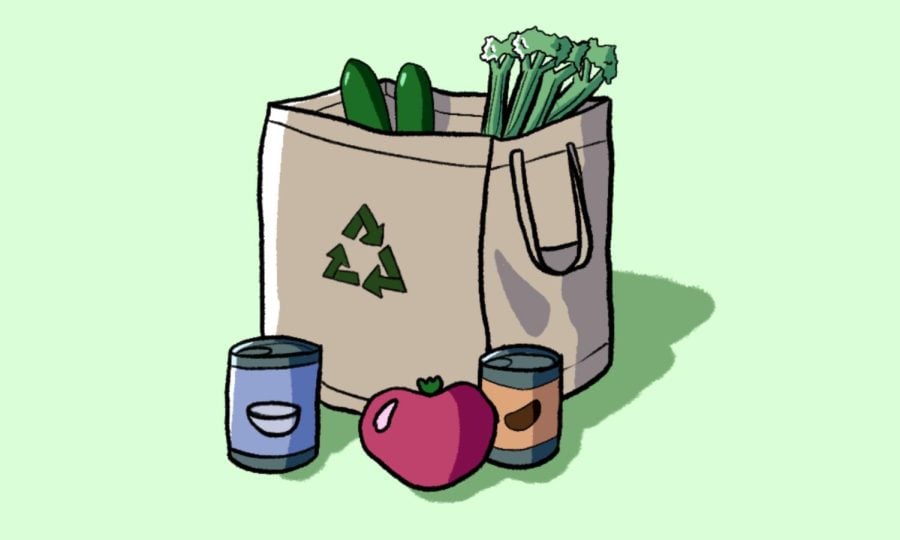Low-income students living off-campus manage food insecurity
Some low-income students say it’s a challenge trying to find affordable grocery options in Evanston.
April 13, 2022
As a low-income student who has lived off campus for two years, McCormick senior Yaritza Chavez doesn’t have a Northwestern meal plan, so she said she has to balance the responsibility of credit card and utility bills in her everyday decisions, especially when grocery shopping.
“The transition from junior year to senior year … that’s been pretty difficult,” Chavez said. “Now (with in-person classes), I have to actually meal plan and pack my food.”
For some low-income students living off campus for the first time, food accessibility is a major concern.
Chavez said she is trying to find time to cook, instead of relying on microwaveable foods like she did during remote learning. She eats a lot of oatmeal and fruit for breakfast, and pasta or sandwiches for a fast, convenient lunch, Chavez said.
Proximity is also a major concern in regard to food access, she said, as transportation often limits how much food she buys because she has to carry groceries back to her apartment.
Chavez said she prefers shopping at Jewel-Osco and Valli Produce because they have affordable options, wider variety and discounts — even though they are a 20- to 30-minute walk from her apartment. Closer options, like the downtown Evanston Target, are costly and do not stock a lot of produce, she said.
“The vegetables are not (really) there,” Chavez said. “They’re overpriced, and second of all, the oranges themselves are bad quality … or go bad very quickly.”
When McCormick senior and low-income student Jennifer Ibarra started living off campus about two years ago, it was the first time she ever had to shop for her own groceries, she said. Since then, she said she’s relied on budgeting.
Ibarra said her financial aid helps her work grocery expenses into her budget.
“Most of my (food) spending money is through my scholarship,” Ibarra said. “Every quarter, I get a refund, and then I basically divide that by the amount of months in a quarter.”
Ibarra said Mint, an app in which users can create a personal budget and set budget goals, has been her number one resource. Her account has categories for grocery shopping and dining out. She said she tries to set aside about $75 for food expenses per week.
SESP junior and low-income student Kasha Akhtar said she is financially mindful when grocery shopping by using coupons. Her favorite sources for couponing are the Target Circle rewards program and Jewel-Osco app, Akhtar said.
“I know we usually throw away the advertisements we get (in the mail), but if we just check, sometimes it’ll be good,” Akhtar said.
Some on-campus services also help students manage food insecurity. Student Enrichment Services helps students apply for federal benefits through the Supplemental Nutrition Assistance Program.
Purple Pantry at the Sheil Catholic Center is a free on-campus option for mainly low-income students struggling with food access. Primarily stocked by donations, it is open every Thursday from 11 a.m. to 2 p.m., and students can fill out a form to request an alternative time.
The pantry offers shelf-stable snacks like chips and cereal, meal ingredients like rice and frozen ground beef, dairy products and fresh produce, along with vegan, gluten-free and halal-friendly options. Students can grab two of most items, according to Sheil Pastoral Associate Mary Deeley, the pantry coordinator.
Deeley said the pantry can only supplement students’ food needs, not replace full meals. However, she said the resource can still be helpful, even for students struggling with food access who are not low-income.
Deeley said in addition to financial reasons, dining hall hours are also a barrier for students, as they may be working when the dining hall is open. She also said the affordable grocery stores’ distance from campus can be an additional obstacle.
“Purple Pantry collects groceries and provides food for students that are food insecure for whatever reason,” Deeley said.
Sheil also offers a table with refreshments and snacks by its lounge area that is always available through the week, Deeley said.
While Purple Pantry stocks up by soliciting donations, Campus Kitchen is a student-supported initiative that collects excess food from dining halls or catered events and redistributes them to low-income Evanston residents. The food is sorted and packaged for individual meals, but there are also nonperishable items like granola bars and cereal, according to Weinberg sophomore and Campus Kitchen Co-President Sean Pascoe.
“We fight food waste while we fight food insecurity,” Pascoe said. “We also have other recovery sources … We work with YMCA, Soup at Six, Evanston community fridges a lot and then we have individual community partners.”
Pascoe said Campus Kitchen is a free resource low-income students should not hesitate to use. To get food, students can either email [email protected], send a message to the group on Instagram or stop by 600 Haven St. Monday, Wednesday or Friday from 4 to 5 p.m. according to Pascoe.
Akhtar said she has engaged with some campus services like Purple Pantry and recommends other low-income students use the resources at their disposal.
“If you’re in a tight spot … I’ve used (Purple Pantry) a few times and it’s good to have things like instant rice, cereal, nuts, fruit bars and things like that,” Akhtar said. “It’s just nice to have on-hand.”
Email: [email protected]
Twitter: @Astry_tpwk
Related Stories:
— Evanston organizations work to fight food insecurity, foster community during pandemic
— Applications for low-income housing support programs are now open. Here’s how you can apply.












